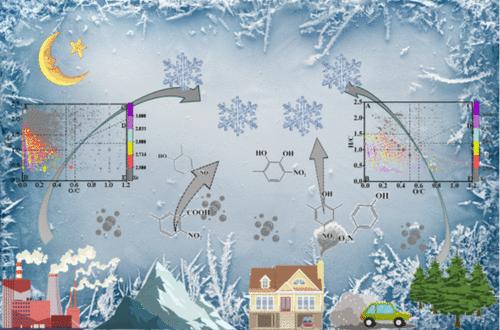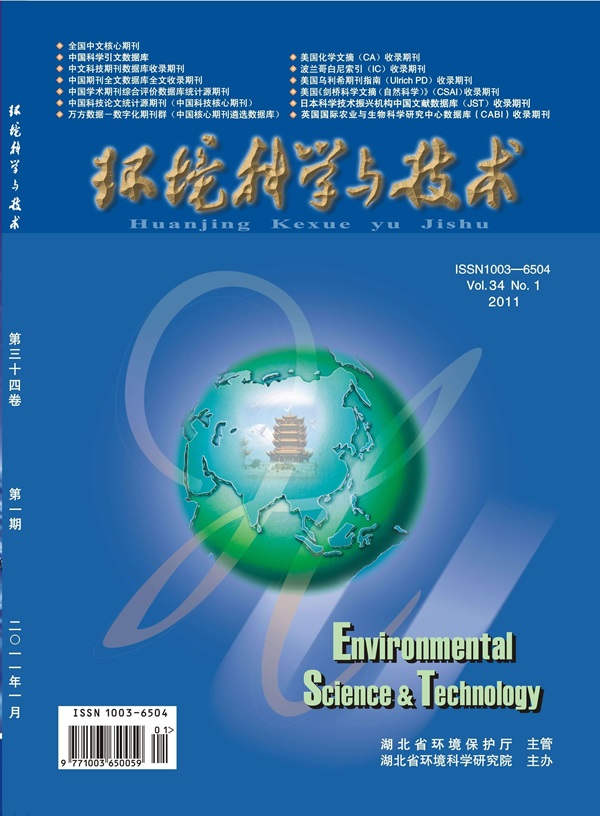东北农村霜湿沉降中含氮有机物的非靶向筛选
IF 11.3
1区 环境科学与生态学
Q1 ENGINEERING, ENVIRONMENTAL
引用次数: 0
摘要
霜冻中含氮有机物(NOCs)是大气氮沉降的重要途径,对氮的生物地球化学循环有重要影响。然而,对NOCs在霜冻中的分子特性及其沉积通量的研究却很少。本文采用非靶向超高高效液相色谱-轨道阱质谱(UHPLC-Orbitrap MS)技术,对2023年冬季中国东北农村地区的霜冻样品进行了分析,揭示了其在含氮有机化合物(NOCs)中的含量,并探讨了其湿沉积通量。雾天与非雾天相比,霜中水溶性(WSOM)和水不溶性有机物(WISOM)分配的平均分子式数量都要多(WSOM为3114比1934,电喷雾电离(ESI−)中WISOM为3042比2224);WSOM为6921比5954,ESI+为6629比5547)。其中,在ESI -和ESI+模式中,CHON的数量比例分别为35.6-49.9%(724-1517)和47-51.1%(2686-3388)。硝基酚(C6H5NO3)和甲基硝基酚(C7H7NO4)是最丰富的NOCs,湿沉降通量(最大平均浓度)分别为22.2和21.2 μg m-2·h-1。在雾霾天气,硝基酚类化合物的沉积通量达到非雾霾天气的1.73倍,表明雾霾期间环境氮沉积显著。该沉降通量与PM2.5浓度正相关,表明大气颗粒物在影响NOC霜冻沉降中发挥了重要作用。这些发现强调了霜冻从大气中捕获NOCs的敏感性,这可能会影响生态系统中的氮循环。本文章由计算机程序翻译,如有差异,请以英文原文为准。

Nontargeted Screening Nitrogen-Containing Organic Compounds in Frost and Wet Deposition in Rural Northeast China
Nitrogen-containing organic compounds (NOCs) in frost serve as a critical pathway for atmospheric nitrogen deposition, significantly impacting the biogeochemical cycles of nitrogen. However, the molecular characteristics of NOCs in frost and their deposition fluxes are scarcely studied. In this work, frost samples, collected in rural Northeast China in the winter of 2023, were analyzed using nontargeted ultrahigh performance liquid chromatography-orbitrap mass spectrometry (UHPLC-Orbitrap MS) to reveal their content in nitrogen-containing organic compounds (NOCs) and explore their wet deposition fluxes. The average number of assigned molecular formulas were lager on hazy days compared to nonhazy days for both water-soluble (WSOM) and water-insoluble organic matter (WISOM) in frost (3114 vs. 1934 for WSOM and 3042 vs. 2224 for WISOM in electrospray ionization (ESI−); 6921 vs. 5954 for WSOM and 6629 vs. 5547 in ESI+). Specifically, the number proportions of CHON were 35.6–49.9% (724–1517) and 47–51.1% (2686–3388) in the ESI– and ESI+ modes, respectively. Nitrophenol (C6H5NO3) and methyl nitrophenol (C7H7NO4) were the most abundant NOCs, with wet deposition fluxes (at maximum average concentrations) of 22.2 and 21.2 μg m–2·h–1, respectively. On hazy days, the deposition fluxes of nitrophenol compounds reached up to 1.73 times that of nonhazy days, indicating significant ambient nitrogen deposition during the haze episode. This deposition flux positively correlated with PM2.5 concentration, implying the important role of atmospheric particulates in influencing NOC deposition through frost. These findings highlight the susceptibility of frost to capturing NOCs from the atmosphere, potentially impacting nitrogen cycling in ecosystems.
求助全文
通过发布文献求助,成功后即可免费获取论文全文。
去求助
来源期刊

环境科学与技术
环境科学-工程:环境
CiteScore
17.50
自引率
9.60%
发文量
12359
审稿时长
2.8 months
期刊介绍:
Environmental Science & Technology (ES&T) is a co-sponsored academic and technical magazine by the Hubei Provincial Environmental Protection Bureau and the Hubei Provincial Academy of Environmental Sciences.
Environmental Science & Technology (ES&T) holds the status of Chinese core journals, scientific papers source journals of China, Chinese Science Citation Database source journals, and Chinese Academic Journal Comprehensive Evaluation Database source journals. This publication focuses on the academic field of environmental protection, featuring articles related to environmental protection and technical advancements.
 求助内容:
求助内容: 应助结果提醒方式:
应助结果提醒方式:


